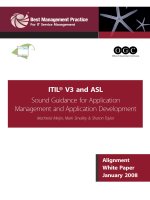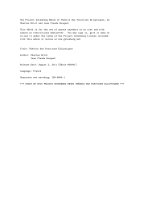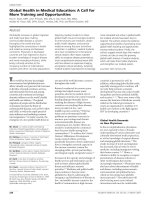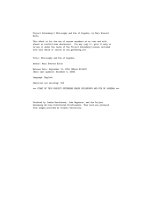MongoDB in action
Bạn đang xem bản rút gọn của tài liệu. Xem và tải ngay bản đầy đủ của tài liệu tại đây (7.47 MB, 482 trang )
IN ACTION
SECOND EDITION
Kyle Banker
Peter Bakkum
Shaun Verch
Douglas Garrett
Tim Hawkins
MANNING
Covers MongoDB version 3.0
MongoDB in Action
MongoDB in Action
Second Edition
KYLE BANKER
PETER BAKKUM
SHAUN VERCH
DOUGLAS GARRETT
TIM HAWKINS
MANNING
SHELTER ISLAND
For online information and ordering of this and other Manning books, please visit
www.manning.com. The publisher offers discounts on this book when ordered in quantity.
For more information, please contact
Special Sales Department
Manning Publications Co.
20 Baldwin Road
PO Box 761
Shelter Island, NY 11964
Email:
©2016 by Manning Publications Co. All rights reserved.
No part of this publication may be reproduced, stored in a retrieval system, or transmitted, in
any form or by means electronic, mechanical, photocopying, or otherwise, without prior written
permission of the publisher.
Many of the designations used by manufacturers and sellers to distinguish their products are
claimed as trademarks. Where those designations appear in the book, and Manning
Publications was aware of a trademark claim, the designations have been printed in initial caps
or all caps.
Recognizing the importance of preserving what has been written, it is Manning’s policy to have
the books we publish printed on acid-free paper, and we exert our best efforts to that end.
Recognizing also our responsibility to conserve the resources of our planet, Manning books
are printed on paper that is at least 15 percent recycled and processed without the use of
elemental chlorine.
Manning Publications Co.
20 Baldwin Road
PO Box 761
Shelter Island, NY 11964
Development editors: Susan Conant, Jeff Bleiel
Technical development editors: Brian Hanafee, Jürgen Hoffman,
Wouter Thielen
Copyeditors: Liz Welch, Jodie Allen
Proofreader: Melody Dolab
Technical proofreader: Doug Warren
Typesetter: Dennis Dalinnik
Cover designer: Marija Tudor
ISBN: 9781617291609
Printed in the United States of America
1 2 3 4 5 6 7 8 9 10 – EBM – 21 20 19 18 17 16
This book is dedicated to peace and human dignity
and to all those who work for these ideals
brief contents
PART 1
PART 2
PART 3
GETTING STARTED . ......................................................1
1
■
A database for the modern web
3
2
■
MongoDB through the JavaScript shell 29
3
■
Writing programs using MongoDB 52
APPLICATION DEVELOPMENT IN MONGODB.................71
4
■
Document-oriented data
73
5
■
Constructing queries 98
6
■
Aggregation 120
7
■
Updates, atomic operations, and deletes
157
MONGODB MASTERY .................................................195
8
■
Indexing and query optimization 197
9
■
Text search 244
10
■
WiredTiger and pluggable storage
11
■
Replication 296
12
■
Scaling your system with sharding
13
■
Deployment and administration 376
vii
273
333
contents
preface xvii
acknowledgments xix
about this book xxi
about the cover illustration
xxiv
PART 1 GETTING STARTED . ...........................................1
1
A database for the modern web 3
1.1
1.2
Built for the internet 5
MongoDB’s key features 6
Document data model 6 Ad hoc queries 10
Indexes 10 Replication 11 Speed and durability 12
Scaling 14
■
■
1.3
■
MongoDB’s core server and tools
Core server 16 JavaScript shell
Command-line tools 18
■
1.4
Why MongoDB?
16
■
Database drivers
18
MongoDB versus other databases 19
production deployments 22
1.5
1.6
15
Tips and limitations 24
History of MongoDB 25
ix
■
Use cases and
17
CONTENTS
x
1.7
1.8
2
Additional resources
Summary 28
27
MongoDB through the JavaScript shell 29
2.1
Diving into the MongoDB shell 30
Starting the shell 30 Databases, collections, and documents
Inserts and queries 32 Updating documents 34
Deleting data 38 Other shell features 38
■
31
■
■
2.2
Creating and querying with indexes 39
Creating a large collection
2.3
Basic administration
39
3
Indexing and explain( )
41
46
Getting database information
2.4
2.5
■
46
■
How commands work 48
Getting help 49
Summary 51
Writing programs using MongoDB 52
3.1
MongoDB through the Ruby lens 53
Installing and connecting
Queries and cursors 56
Database commands 58
3.2
How the drivers work
Object ID generation
3.3
59
59
Building a simple application
Setting up 61
3.4
53 Inserting documents in Ruby 55
Updates and deletes 57
■
■
■
61
Gathering data 62
■
Viewing the archive
65
Summary 69
PART 2 APPLICATION DEVELOPMENT IN MONGODB .....71
4
Document-oriented data 73
4.1
4.2
Principles of schema design 74
Designing an e-commerce data model
Schema basics 76
4.3
Users and orders 80
75
■
Reviews 83
Nuts and bolts: On databases, collections,
and documents 84
Databases 84
4.4
■
Summary 96
■
Collections 87
■
Documents and insertion 92
CONTENTS
5
xi
Constructing queries 98
5.1
E-commerce queries
99
Products, categories, and reviews
5.2
MongoDB’s query language
Query criteria and selectors
5.3
6
99
■
Users and orders
101
103
103
■
Query options 117
Summary 119
Aggregation 120
6.1
6.2
Aggregation framework overview 121
E-commerce aggregation example 123
Products, categories, and reviews 125
User and order 132
6.3
Aggregation pipeline operators 135
$project 136 $group 136 $match, $sort,
$skip, $limit 138 $unwind 139 $out 139
■
■
■
6.4
■
Reshaping documents
140
String functions 141 Arithmetic functions 142
Date functions 142 Logical functions 143
Set Operators 144 Miscellaneous functions 145
■
■
■
6.5
Understanding aggregation pipeline performance 146
Aggregation pipeline options 147 The aggregation framework’s
explain( ) function 147 allowDiskUse option 151
Aggregation cursor option 151
■
■
6.6
Other aggregation capabilities
.count( ) and .distinct( )
6.7
7
153
■
152
map-reduce 153
Summary 156
Updates, atomic operations, and deletes 157
7.1
A brief tour of document updates 158
Modify by replacement 159 Modify by operator 159
Both methods compared 160 Deciding: replacement
vs. operators 160
■
■
7.2
E-commerce updates 162
Products and categories
7.3
162
Reviews 167
■
Atomic document processing
Order state transitions
172
■
■
Orders
168
171
Inventory management 174
CONTENTS
xii
7.4
Nuts and bolts: MongoDB updates and deletes
179
Update types and options 179 Update operators 181
The findAndModify command 188 Deletes 189
Concurrency, atomicity, and isolation 190
Update performance notes 191
■
■
7.5
7.6
Reviewing update operators
Summary 193
192
PART 3 MONGODB MASTERY .....................................195
8
Indexing and query optimization 197
8.1
Indexing theory 198
A thought experiment 198
B-trees 205
8.2
Indexing in practice
Index types
8.3
207
9
201
207
Index administration 211
■
Query optimization
216
Identifying slow queries
Query patterns 241
8.4
Core indexing concepts
■
217
■
Examining slow queries
221
Summary 243
Text search 244
9.1
Text searches—not just pattern matching 245
Text searches vs. pattern matching 246 Text searches vs.
web page searches 247 MongoDB text search vs. dedicated
text search engines 250
■
■
9.2
9.3
Manning book catalog data download
Defining text search indexes 255
253
Text index size 255 Assigning an index name and indexing
all text fields in a collection 256
■
9.4
Basic text search
257
More complex searches 259 Text search scores
Sorting results by text search score 262
■
9.5
261
Aggregation framework text search 263
Where’s MongoDB in Action, Second Edition?
265
CONTENTS
9.6
Text search languages
xiii
267
Specifying language in the index 267 Specifying the language in
the document 269 Specifying the language in a search 269
Available languages 271
■
■
9.7
10
Summary 272
WiredTiger and pluggable storage 273
10.1
10.2
Pluggable Storage Engine API
273
Why use different storages engines?
274
WiredTiger
275
Switching to WiredTiger
to WiredTiger 277
10.3
276
Migrating your database
■
Comparison with MMAPv1
278
Configuration files 279 Insertion script and
benchmark script 281 Insertion benchmark results 283
Read performance scripts 285 Read performance results 286
Benchmark conclusion 288
■
■
■
10.4
10.5
Other examples of pluggable storage engines
Advanced topics 290
How does a pluggable storage engine work?
Data structure 292 Locking 294
290
■
10.6
11
Summary
Replication
11.1
295
296
Replication overview
297
Why replication matters
and limitations 298
11.2
Replica sets
297
■
Replication use cases
300
Setup 300 How replication works
Administration 314
■
11.3
Drivers and replication
307
324
Connections and failover 324 Write concern
Read scaling 328 Tagging 330
■
■
11.4
Summary
332
327
289
CONTENTS
xiv
12
Scaling your system with sharding 333
12.1
Sharding overview
334
What is sharding? 334
12.2
■
When should you shard? 335
Understanding components of a sharded cluster 336
Shards: storage of application data 337 Mongos router: router
of operations 338 Config servers: storage of metadata 338
■
■
12.3
Distributing data in a sharded cluster
339
Ways data can be distributed in a sharded cluster 340
Distributing databases to shards 341 Sharding within
collections 341
■
12.4
Building a sample shard cluster
343
Starting the mongod and mongos servers 343
the cluster 346 Sharding collections 347
sharded cluster 349
■
12.5
Querying and indexing a shard cluster
■
■
Configuring
Writing to a
355
Query routing 355 Indexing in a sharded cluster 356
The explain() tool in a sharded cluster 357 Aggregation in
a sharded cluster 359
■
■
12.6
Choosing a shard key 359
Imbalanced writes (hotspots) 360 Unsplittable chunks (coarse
granularity) 362 Poor targeting (shard key not present
in queries) 362 Ideal shard keys 363 Inherent design
trade-offs (email application) 364
■
■
■
12.7
Sharding in production
Provisioning 366
12.8
13
■
Summary
■
365
Deployment
369
■
Maintenance 370
375
Deployment and administration 376
13.1
Hardware and provisioning
Cluster topology 377
Provisioning 385
13.2
■
377
Deployment environment 378
Monitoring and diagnostics
386
Logging 387 MongoDB diagnostic commands 387
MongoDB diagnostic tools 388 MongoDB Monitoring
Service 390 External monitoring applications 390
■
■
■
13.3
Backups 391
mongodump and mongorestore 391 Data file–based
backups 392 MMS backups 393
■
■
CONTENTS
13.4
xv
Security 394
Secure environments 394 Network encryption 395
Authentication 397 Replica set authentication 401
Sharding authentication 402 Enterprise security features
■
■
402
■
13.5
Administrative tasks
402
Data imports and exports
Upgrading 405
13.6
402
■
Performance troubleshooting
Working set 406
Query interactions
■
Deployment checklist
Summary 410
appendix A
appendix B
appendix C
Installation 411
Design patterns 421
Binary data and GridFS
■
408
433
403
405
Performance cliff 407
407 Seek professional assistance
13.7
13.8
index 441
Compaction and repair
408
preface
Databases are the workhorses of the information age. Like Atlas, they go largely unnoticed in supporting the digital world we’ve come to inhabit. It’s easy to forget that our
digital interactions, from commenting and tweeting to searching and sorting, are in
essence interactions with a database. Because of this fundamental yet hidden function, I always experience a certain sense of awe when thinking about databases, not
unlike the awe one might feel when walking across a suspension bridge normally
reserved for automobiles.
The database has taken many forms. The indexes of books and the card catalogs
that once stood in libraries are both databases of a sort, as are the ad hoc structured
text files of the Perl programmers of yore. Perhaps most recognizable now as databases proper are the sophisticated, fortune-making relational databases that underlie
much of the world’s software. These relational databases, with their idealized thirdnormal forms and expressive SQL interfaces, still command the respect of the old
guard, and appropriately so.
But as a working web application developer a few years back, I was eager to sample
the emerging alternatives to the reigning relational database. When I discovered
MongoDB, the resonance was immediate. I liked the idea of using a JSON-like structure to represent data. JSON is simple, intuitive, and human-friendly. That MongoDB
also based its query language on JSON lent a high degree of comfort and harmony to
the usage of this new database. The interface came first. Compelling features like easy
replication and sharding made the package all the more intriguing. And by the time
xvii
xviii
PREFACE
I’d built a few applications on MongoDB and beheld the ease of development it
imparted, I’d become a convert.
Through an unlikely turn of events, I started working for 10gen, the company
spearheading the development of this open source database. For two years, I’ve had
the opportunity to improve various client drivers and work with numerous customers
on their MongoDB deployments. The experience gained through this process has, I
hope, been distilled faithfully into the book you’re reading now.
As a piece of software and a work in progress, MongoDB is still far from perfection.
But it’s also successfully supporting thousands of applications atop database clusters
small and large, and it’s maturing daily. It’s been known to bring out wonder, even
happiness, in many a developer. My hope is that it can do the same for you.
This is the second edition of MongoDB in Action and I hope that you enjoy reading the book!
KYLE BANKER
acknowledgments
Thanks are due to folks at Manning for helping make this book a reality. Michael
Stephens helped conceive the first edition of this book, and my development editors
for this second edition, Susan Conant, Jeff Bleiel, and Maureen Spencer, pushed the
book to completion while being helpful along the way. My thanks go to them.
Book writing is a time-consuming enterprise. I feel I wouldn’t have found the time
to finish this book had it not been for the generosity of Eliot Horowitz and Dwight
Merriman. Eliot and Dwight, through their initiative and ingenuity, created MongoDB,
and they trusted me to document the project. My thanks to them.
Many of the ideas in this book owe their origins to conversations I had with colleagues at 10gen. In this regard, special thanks are due to Mike Dirolf, Scott Hernandez,
Alvin Richards, and Mathias Stearn. I’m especially indebted to Kristina Chowdorow,
Richard Kreuter, and Aaron Staple for providing expert reviews of entire chapters for
the first edition.
The following reviewers read the manuscript of the first edition at various stages
during its development: Kevin Jackson, Hardy Ferentschik, David Sinclair, Chris
Chandler, John Nunemaker, Robert Hanson, Alberto Lerner, Rick Wagner, Ryan Cox,
Andy Brudtkuhl, Daniel Bretoi, Greg Donald, Sean Reilly, Curtis Miller, Sanchet
Dighe, Philip Hallstrom, and Andy Dingley. And I am also indebted to all the reviewers who read the second edition, including Agustin Treceno, Basheeruddin Ahmed,
Gavin Whyte, George Girton, Gregor Zurowski, Hardy Ferentschik, Hernan Garcia,
Jeet Marwah, Johan Mattisson, Jonathan Thoms, Julia Varigina, Jürgen Hoffmann,
Mike Frey, Phlippie Smith, Scott Lyons, and Steve Johnson. Special thanks go to Wouter
Thielen for his work on chapter 10, technical editor Mihalis Tsoukalos, who devoted
xix
xx
ACKNOWLEDGMENTS
many hours to whipping the second edition into shape, and to Doug Warren for his
thorough technical review of the second edition shortly before it went to press.
My amazing wife, Dominika, offered her patience and support, through the writing
of both editions of this book, and to my wonderful son, Oliver, just for being awesome.
KYLE BANKER
about this book
This book is for application developers and DBAs wanting to learn MongoDB from the
ground up. If you’re new to MongoDB, you’ll find in this book a tutorial that moves at
a comfortable pace. If you’re already a user, the more detailed reference sections in
the book will come in handy and should fill any gaps in your knowledge. In terms of
depth, the material should be suitable for all but the most advanced users. Although
the book is about the latest MongoDB version, which at the time of writing is 3.0.x, it
also covers the previous stable MongoDB version that is 2.6.
The code examples are written in JavaScript, the language of the MongoDB shell,
and Ruby, a popular scripting language. Every effort has been made to provide simple
but useful examples, and only the plainest features of the JavaScript and Ruby languages are used. The main goal is to present the MongoDB API in the most accessible
way possible. If you have experience with other programming languages, you should
find the examples easy to follow.
One more note about languages. If you’re wondering, “Why couldn’t this book use
language X?” you can take heart. The officially supported MongoDB drivers feature
consistent and analogous APIs. This means that once you learn the basic API for one
driver, you can pick up the others fairly easily.
How to use this book
This book is part tutorial, part reference. If you’re brand-new to MongoDB, then reading through the book in order makes a lot of sense. There are numerous code examples that you can run on your own to help solidify the concepts. At minimum, you’ll
xxi
ABOUT THIS BOOK
xxii
need to install MongoDB and optionally the Ruby driver. Instructions for these installations can be found in appendix A.
If you’ve already used MongoDB, then you may be more interested in particular
topics. Chapters 8 to 13 and all of the appendixes stand on their own and can safely be
read in any order. Additionally, chapters 4 to 7 contain the so-called “nuts and bolts”
sections, which focus on fundamentals. These also can be read outside the flow of the
surrounding text.
Roadmap
This book is divided into three parts.
Part 1 is an end-to-end introduction to MongoDB. Chapter 1 gives an overview of
MongoDB’s history, features, and use cases. Chapter 2 teaches the database’s core concepts through a tutorial on the MongoDB command shell. Chapter 3 walks through
the design of a simple application that uses MongoDB on the back end.
Part 2 is an elaboration on the MongoDB API presented in part 1. With a specific
focus on application development, the four chapters in part 2 progressively describe a
schema and its operations for an e-commerce app. Chapter 4 delves into documents,
the smallest unit of data in MongoDB, and puts forth a basic e-commerce schema
design. Chapters 5, 6, and 7 then teach you how to work with this schema by covering
queries and updates. To augment the presentation, each of the chapters in part 2 contains a detailed breakdown of its subject matter.
Part 3 focuses on MongoDB mastery. Chapter 8 is a thorough study of indexing
and query optimization. The subject of Chapter 9 is text searching inside MongoDB.
Chapter 10, which is totally new in this edition, is about the WiredTiger storage engine
and pluggable storage, which are unique features of MongoDB v3. Chapter 11 concentrates on replication, with strategies for deploying MongoDB for high availability and
read scaling. Chapter 12 describes sharding, MongoDB’s path to horizontal scalability.
And chapter 13 provides a series of best practices for deploying, administering, and
troubleshooting MongoDB installations.
The book ends with three appendixes. Appendix A covers installation of MongoDB
and Ruby (for the driver examples) on Linux, Mac OS X, and Windows. Appendix B
presents a series of schema and application design patterns, and it also includes a list
of anti-patterns. Appendix C shows how to work with binary data in MongoDB and
how to use GridFS, a spec implemented by all the drivers, to store especially large files
in the database.
Code conventions and downloads
All source code in the listings and in the text is presented in a fixed-width font,
which separates it from ordinary text.
Code annotations accompany some of the listings, highlighting important concepts. In some cases, numbered bullets link to explanations that follow in the text.
ABOUT THIS BOOK
xxiii
As an open source project, 10gen keeps MongoDB’s bug tracker open to the community at large. At several points in the book, particularly in the footnotes, you’ll see
references to bug reports and planned improvements. For example, the ticket for
adding full-text search to the database is SERVER-380. To view the status of any such
ticket, point your browser to , and enter the ticket ID in the
search box.
You can download the book’s source code, with some sample data, from the book’s
site at as well as from the publisher’s website at http://
manning.com/MongoDBinAction.
Software requirements
To get the most out of this book, you’ll need to have MongoDB installed on your system. Instructions for installing MongoDB can be found in appendix A and also on the
official MongoDB website ().
If you want to run the Ruby driver examples, you’ll also need to install Ruby. Again,
consult appendix A for instructions on this.
Author Online
The purchase of MongoDB in Action, Second Edition includes free access to a private
forum run by Manning Publications where you can make comments about the book,
ask technical questions, and receive help from the author and other users. To access
and subscribe to the forum, point your browser to www.manning.com/MongoDBinAction. This page provides information on how to get on the forum once you are registered, what kind of help is available, and the rules of conduct in the forum.
Manning’s commitment to our readers is to provide a venue where a meaningful
dialogue between individual readers and between readers and the author can take
place. It’s not a commitment to any specific amount of participation on the part of the
author, whose contribution to the book’s forum remains voluntary (and unpaid). We
suggest you try asking him some challenging questions, lest his interest stray!
The Author Online forum and the archives of previous discussions will be accessible from the publisher’s website as long as the book is in print.
about the cover illustration
The figure on the cover of MongoDB in Action is captioned “Le Bourginion,” or a resident of the Burgundy region in northeastern France. The illustration is taken from a
nineteenth-century collection of works by many artists, edited by Louis Curmer and
published in Paris in 1841. The title of the collection is Les Français peints par euxmêmes, which translates as The French People Painted by Themselves. Each illustration is
finely drawn and colored by hand, and the rich variety of drawings in the collection
reminds us vividly of how culturally apart the world’s regions, towns, villages, and
neighborhoods were just 200 years ago. Isolated from each other, people spoke different dialects and languages. In the streets or in the countryside, it was easy to identify
where they lived and what their trade or station in life was just by their dress.
Dress codes have changed since then and the diversity by region, so rich at the
time, has faded away. It is now hard to tell apart the inhabitants of different continents, let alone different towns or regions. Perhaps we have traded cultural diversity
for a more varied personal life—certainly for a more varied and fast-paced technological life.
At a time when it is hard to tell one computer book from another, Manning celebrates the inventiveness and initiative of the computer business with book covers
based on the rich diversity of regional life of two centuries ago, brought back to life by
pictures from collections such as this one.
xxiv









